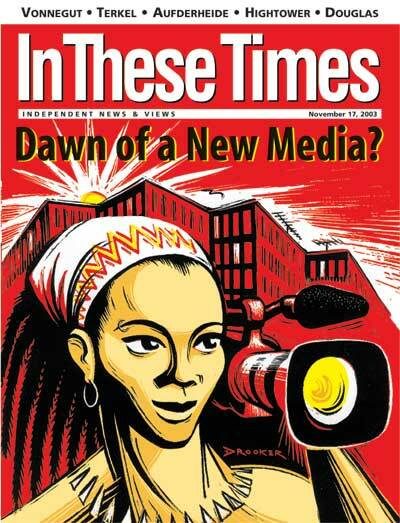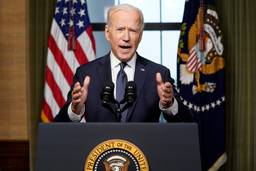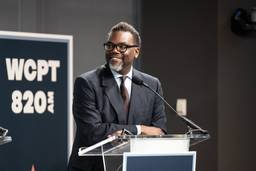The major news outlets are like walls with cracks. The confining structures of big media loom large every day—yet progressives have countless opportunities to find, utilize and widen the cracks in the corporate media’s barriers to democratic communication.
Steadily worsening concentrations of ownership and the hefty clout of advertising combine to severely limit the range of information and debate in news media. Ongoing pressures—economic, ideological and governmental—constrain the work of mainline journalists, whose efforts routinely suffer from skewed priorities and self-censorship. A profit-driven ideology of the “free market” is in sync with the agendas of top management and advertisers.
In recent years, progressive media projects have gained momentum. But the tilt against truly independent media and wide-ranging discourse is extreme in the United States. While no individual or single organization can take on more than a fraction of the necessary endeavors, the overall work to create a democratic media environment must run a gamut.
Sustained challenges to the corporate media and support for alternative media outlets can reinforce each other with continuous synergy—to establish, sustain and expand progressive media organizations; to spread deft criticism of rancid mass media; to push for better reporting and much wider debate in mainstream media; to fight for structural reform of agencies like the FCC; to lambast, debunk and satirize the insidious junk that so often passes for journalism and cultural uplift.
The horrendous media problems are multifaceted. Our solutions must be, as well.
In the long run, no campaign for basic media reform can succeed apart from a broader progressive movement—and vice versa. The degradation of journalism and mass entertainment is entwined with pervasive corporate power that chokes virtually every facet of this country’s political and social life.
Media criticism becomes profoundly useful in combination with media activism. Too often we’ve held onto theories about what is and is not possible. But analysis and action become much more powerful when they constantly inform each other—when assessments shift because of on-the-ground experiences that benefit not only from the results of trial and error but from insightful up-to-date analysis.
Along with theory and practice that keep enhancing each other, we need a lot more resources for the media tasks ahead. Many left-leaning foundations remain hesitant or unwilling to fund media work, and the ones that do often are leery of backing media endeavors that seem overly combative or ideological. Not so the right-wing foundations and corporations that sink millions of dollars a week into aggressive media-savvy propaganda outfits like the Heritage Foundation, the American Enterprise Institute and the Manhattan Institute. Likewise, intensely ideological media organs like the Murdoch-owned Weekly Standard magazine are able to gain national prominence and maintain influence thanks to large subsidies from right-wing backers.
As a fundamental matter of social-change strategy, progressive media institutions—including groups that focus on improving mainstream media coverage as well as on building radio, TV, video, print and Internet projects—merit support to narrow the gaps between their skimpy resources and the huge budgets for right-wing media. This is especially important because the left has to navigate media terrain that’s appreciably less hospitable.
One of the political right’s key advantages is the mass-media echo chamber. Many a spun story and loopy canard bounces around the walls among outlets like the Washington Times, Rush Limbaugh’s radio show, the Wall Street Journal editorial page, the Weekly Standard and Fox News. Frequently, from there, the dubious stories and simple-minded polemics flood into mainstream talk shows, daily papers, slick magazines, broadcast news outlets and cable TV networks.
Progressives have nothing comparable in terms of nationwide echo chambers. And the disparity often makes a pivotal difference. It’s not nearly enough to put out a powerful exposé or release a cogent analysis in a few print outlets or on some Web sites or on a few dozen radio stations—or to briefly surface in a large national media venue. Such achievements, while important, are insufficient. They need to draw strength from each other—utilizing the best material available across the progressive board—while simultaneously finding ways to reach broader audiences, including via mass media, where cracks in the corporate walls beckon.
During the last few years, progressive advocates and independent journalists have learned a lot about how to realize “multiplier effects” among a wide array of media. When astute strategizing and cooperation flourish, we’re finding ways to reach many people—sometimes millions or tens of millions—with information and analysis that otherwise would be confined to a relative few. The potential for further developing such productive media synergy is enormous.
In the process, what’s needed is to strengthen the many progressive media organizations that have been developing skills, infrastructures and cooperative spirit and to grasp what is clearly possible—mutually supportive operations that cross-pollinate across extensive media terrain and propagate resistance to the status quo’s deadening and often deadly corporate priorities.
While regularly affecting the content of major media outlets, the progressive media movement needs counter-institutions that can inspire and sustain many people for the challenges ahead. No one media project is a potential solution by itself. No silver bullets need apply. At the same time, progressive funders ought to provide long-term support for an array of media work. By now, there are enough track records out there to supply empirical evidence of impressive results.
We urgently need to boost the resources and improve the coordination of progressive media work. Sure, by definition, corporate media and their allies inevitably have big bucks that dwarf the outlays of anti-corporate crusaders. Extreme imbalances in funding come with the media territory. But in his fabled confrontation with Goliath, even David needed a slingshot. Long-term progressive media projects of all descriptions need at least minimal resources along with savvy strategies to put up a strong fight and make appreciable headway.
Meanwhile, our guiding ethos should be notably different than the right wing’s preferred mode of top-down centralism. It should be possible for progressives to attain the creative advantages of sharp analysis, institutional growth, coordinated planning and agile cooperation while encouraging a decentralized, democratic, grassroots approach to social action.
Along the way, we should resist temptations to rely on a few left heroes on the mass-media battlefields. In the mid-1990s, while working on the launch of the Institute for Public Accuracy as a national consortium to get progressive voices into media, I received some advice to concentrate on grooming a few “superstars” to become regulars on national television. But the Institute opted for a different approach: to develop a roster of many hundreds of policy analysts—including researchers, authors and other experts from academia, public-interest groups and grassroots organizations—representing a deep reservoir of knowledge and insights that routinely go untapped in the mass media.
This approach doesn’t just move forward a few individuals and organizations; it widens the bounds of media discussion on a regular basis, not merely on occasion. Media outreach that successfully reflects the breadth and depth of progressive constituencies is more effective at being persuasive—and more capable of withstanding the right wing’s demonizations of a few individuals or accusations of elitism.
A process already underway places scores of different progressives on national television each season, along with hundreds of appearances on a variety of radio programs. Best of all, many of those analysts remain in producer Rolodexes, so their voices will be heard again and again. Clearly, a lot more can be accomplished to move progressive advocates into mainstream media on a regular basis.
Overall, what’s needed in our society—and what a progressive media movement should strive for—is a kind of media ecology that recognizes and promotes authentic diversity. This diversity holds great promise: not because of any mechanistic or PC concepts but because tremendous human capacities and insights, routinely excluded from major media, are always present in the United States and the rest of the world.
Right now the cracks in the media walls are much too thin and much too scarce. The long haul of our struggle involves bringing down the institutional barriers that, in effect, soundproof much of the media world and muffle the First Amendment in the process. We can chip away at those walls and replace them with vibrant democratic discourse.
Steadily worsening concentrations of ownership and the hefty clout of advertising combine to severely limit the range of information and debate in news media. Ongoing pressures—economic, ideological and governmental—constrain the work of mainline journalists, whose efforts routinely suffer from skewed priorities and self-censorship. A profit-driven ideology of the “free market” is in sync with the agendas of top management and advertisers.
In recent years, progressive media projects have gained momentum. But the tilt against truly independent media and wide-ranging discourse is extreme in the United States. While no individual or single organization can take on more than a fraction of the necessary endeavors, the overall work to create a democratic media environment must run a gamut.
Sustained challenges to the corporate media and support for alternative media outlets can reinforce each other with continuous synergy—to establish, sustain and expand progressive media organizations; to spread deft criticism of rancid mass media; to push for better reporting and much wider debate in mainstream media; to fight for structural reform of agencies like the FCC; to lambast, debunk and satirize the insidious junk that so often passes for journalism and cultural uplift.
The horrendous media problems are multifaceted. Our solutions must be, as well.
In the long run, no campaign for basic media reform can succeed apart from a broader progressive movement—and vice versa. The degradation of journalism and mass entertainment is entwined with pervasive corporate power that chokes virtually every facet of this country’s political and social life.
Media criticism becomes profoundly useful in combination with media activism. Too often we’ve held onto theories about what is and is not possible. But analysis and action become much more powerful when they constantly inform each other—when assessments shift because of on-the-ground experiences that benefit not only from the results of trial and error but from insightful up-to-date analysis.
Securing stable funding
Along with theory and practice that keep enhancing each other, we need a lot more resources for the media tasks ahead. Many left-leaning foundations remain hesitant or unwilling to fund media work, and the ones that do often are leery of backing media endeavors that seem overly combative or ideological. Not so the right-wing foundations and corporations that sink millions of dollars a week into aggressive media-savvy propaganda outfits like the Heritage Foundation, the American Enterprise Institute and the Manhattan Institute. Likewise, intensely ideological media organs like the Murdoch-owned Weekly Standard magazine are able to gain national prominence and maintain influence thanks to large subsidies from right-wing backers.
As a fundamental matter of social-change strategy, progressive media institutions—including groups that focus on improving mainstream media coverage as well as on building radio, TV, video, print and Internet projects—merit support to narrow the gaps between their skimpy resources and the huge budgets for right-wing media. This is especially important because the left has to navigate media terrain that’s appreciably less hospitable.
Echoing one another
One of the political right’s key advantages is the mass-media echo chamber. Many a spun story and loopy canard bounces around the walls among outlets like the Washington Times, Rush Limbaugh’s radio show, the Wall Street Journal editorial page, the Weekly Standard and Fox News. Frequently, from there, the dubious stories and simple-minded polemics flood into mainstream talk shows, daily papers, slick magazines, broadcast news outlets and cable TV networks.
Progressives have nothing comparable in terms of nationwide echo chambers. And the disparity often makes a pivotal difference. It’s not nearly enough to put out a powerful exposé or release a cogent analysis in a few print outlets or on some Web sites or on a few dozen radio stations—or to briefly surface in a large national media venue. Such achievements, while important, are insufficient. They need to draw strength from each other—utilizing the best material available across the progressive board—while simultaneously finding ways to reach broader audiences, including via mass media, where cracks in the corporate walls beckon.
During the last few years, progressive advocates and independent journalists have learned a lot about how to realize “multiplier effects” among a wide array of media. When astute strategizing and cooperation flourish, we’re finding ways to reach many people—sometimes millions or tens of millions—with information and analysis that otherwise would be confined to a relative few. The potential for further developing such productive media synergy is enormous.
In the process, what’s needed is to strengthen the many progressive media organizations that have been developing skills, infrastructures and cooperative spirit and to grasp what is clearly possible—mutually supportive operations that cross-pollinate across extensive media terrain and propagate resistance to the status quo’s deadening and often deadly corporate priorities.
Spreading the burden
While regularly affecting the content of major media outlets, the progressive media movement needs counter-institutions that can inspire and sustain many people for the challenges ahead. No one media project is a potential solution by itself. No silver bullets need apply. At the same time, progressive funders ought to provide long-term support for an array of media work. By now, there are enough track records out there to supply empirical evidence of impressive results.
We urgently need to boost the resources and improve the coordination of progressive media work. Sure, by definition, corporate media and their allies inevitably have big bucks that dwarf the outlays of anti-corporate crusaders. Extreme imbalances in funding come with the media territory. But in his fabled confrontation with Goliath, even David needed a slingshot. Long-term progressive media projects of all descriptions need at least minimal resources along with savvy strategies to put up a strong fight and make appreciable headway.
Meanwhile, our guiding ethos should be notably different than the right wing’s preferred mode of top-down centralism. It should be possible for progressives to attain the creative advantages of sharp analysis, institutional growth, coordinated planning and agile cooperation while encouraging a decentralized, democratic, grassroots approach to social action.
Hanging together
Along the way, we should resist temptations to rely on a few left heroes on the mass-media battlefields. In the mid-1990s, while working on the launch of the Institute for Public Accuracy as a national consortium to get progressive voices into media, I received some advice to concentrate on grooming a few “superstars” to become regulars on national television. But the Institute opted for a different approach: to develop a roster of many hundreds of policy analysts—including researchers, authors and other experts from academia, public-interest groups and grassroots organizations—representing a deep reservoir of knowledge and insights that routinely go untapped in the mass media.
This approach doesn’t just move forward a few individuals and organizations; it widens the bounds of media discussion on a regular basis, not merely on occasion. Media outreach that successfully reflects the breadth and depth of progressive constituencies is more effective at being persuasive—and more capable of withstanding the right wing’s demonizations of a few individuals or accusations of elitism.
A process already underway places scores of different progressives on national television each season, along with hundreds of appearances on a variety of radio programs. Best of all, many of those analysts remain in producer Rolodexes, so their voices will be heard again and again. Clearly, a lot more can be accomplished to move progressive advocates into mainstream media on a regular basis.
Overall, what’s needed in our society—and what a progressive media movement should strive for—is a kind of media ecology that recognizes and promotes authentic diversity. This diversity holds great promise: not because of any mechanistic or PC concepts but because tremendous human capacities and insights, routinely excluded from major media, are always present in the United States and the rest of the world.
Right now the cracks in the media walls are much too thin and much too scarce. The long haul of our struggle involves bringing down the institutional barriers that, in effect, soundproof much of the media world and muffle the First Amendment in the process. We can chip away at those walls and replace them with vibrant democratic discourse.
Norman Solomon is founder and executive director of the Institute for Public Accuracy, a national consortium of policy researchers. He is the author of Made Love, Got War and War Made Easy: How Presidents and Pundits Keep Spinning Us to Death, which has been adapted into a documentary film of the same name.







